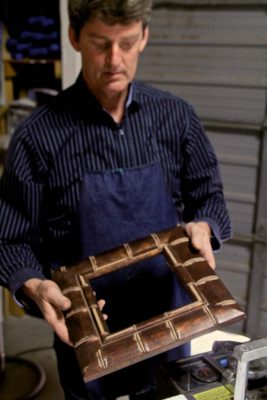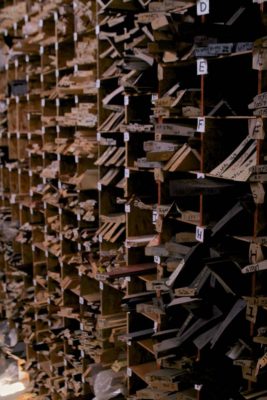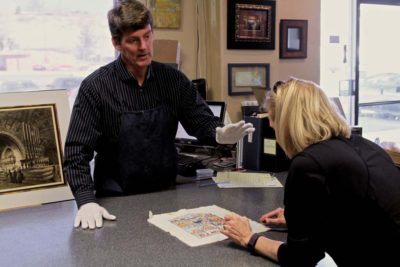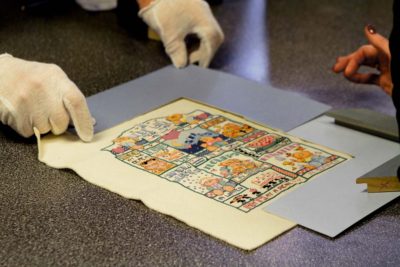The Art of Framing
Never a dull moment in this businessman’s life—with over 30 years in the industry, Doug Anthony Woloschek doesn’t slow down. Up at 4 a.m. everyday, he continues to look for innovative ways to step ahead of his competition in an industry some say is a dying breed. Woloschek, owner of Art Masters on El Paso’s Westside, attends continuing education classes on a yearly basis and recently traveled to a national conference and seminar in Las Vegas to master the art of framing—inviting a small group of gallery owners and artists to join him.
I traveled in late January for five days with Doug, the director of the Tom Lea Institute Arturo Flores, and artist Pat O’Winston to study the professional’s way of framing and brush up on design skills. Students from around the world journeyed to Las Vegas to learn from the masters in the industry offering 100 distinct classes, from colors and textures, technology and technique to educating the novices, enriching the masters and offering classes in marketing, social media and administrative practices.

Doug, the West Coast Art and Frame Expo is really a big event. For those that may not comprehend how this conference affects your business, can you walk us through the significance?
I have been attending this conference for six years. Each year I take staff members, and invite artists and gallery owners like you. This is an incredible opportunity to be taught by some of the masters in the art, design and framing world. There is an endless amount of classes you can take to enhance your level of education not just in framing, but also additionally in business and marketing.
Do you take your new employees or staff with tenure?
Both. There is so much to learn—from the basics to actually becoming a member of the master framers association, PPFA, which is Professional Picture Framers Association. They set the standards in framing.
Is being a member of PPFA similar to having a BA in framing?
 Yes and no. Paul MacFarland, who is an internationally recognized master framer taught one of my classes this year. He has a MCPF (Master Certified Picture Framer) with over 30 years in the industry. He is a key instructor at the conference and every year they update the standards. You are introduced to the latest in product development. In his class we were shown what people are doing with reclaimed materials that doesn’t produce an outgas, which can harm your artwork. So they try and keep you updated in the latest technology and setting the international standards for preservation and conservation. There is a right way of conserving artwork and there is a wrong way.
Yes and no. Paul MacFarland, who is an internationally recognized master framer taught one of my classes this year. He has a MCPF (Master Certified Picture Framer) with over 30 years in the industry. He is a key instructor at the conference and every year they update the standards. You are introduced to the latest in product development. In his class we were shown what people are doing with reclaimed materials that doesn’t produce an outgas, which can harm your artwork. So they try and keep you updated in the latest technology and setting the international standards for preservation and conservation. There is a right way of conserving artwork and there is a wrong way.
Tell me about some of the classes you took.
This year was the third year in a row that I took a shadow box class. Each time I go to that class I learn 15-20 new things, just in that class alone. I learned new ways to use tulle to wrap items instead of gluing the work down; I studied Mylar wraps, new ways of hinging, creative cuts on mats, and viewed the latest trends in design frames. What is interesting is designers say the new wall color is white and trending colors this year are blue and pink! I also learned incredibly enough about object framing—like how to frame a violin in a conservation manner and believe it or not, I learned ways to connect in the social media world.
We both attended a class on hinging. What did you take away from it and how can you apply that information to your business?
 Hinging is the process of holding the artwork in place to attach to a mat or foam board. In doing so by direct contact it needs to be executed properly in a preservation manner—this is incredibly important. There are different ways the professor showed us, for example rice starch is brushed on the back side of the rice paper and that allows for the adhesive to be placed on the back of the artwork that won’t do any damage to the artwork and the process is reversible. I am going to be offering a class at my store in the spring on hinging this year because it is so vital to preservation.
Hinging is the process of holding the artwork in place to attach to a mat or foam board. In doing so by direct contact it needs to be executed properly in a preservation manner—this is incredibly important. There are different ways the professor showed us, for example rice starch is brushed on the back side of the rice paper and that allows for the adhesive to be placed on the back of the artwork that won’t do any damage to the artwork and the process is reversible. I am going to be offering a class at my store in the spring on hinging this year because it is so vital to preservation.
What was one of the biggest lessons learned?
You can take all of those classes every day of the week and constantly learn. This business keeps changing, adding layer upon layer. If you went last year and didn’t go this year, trust me you missed something as this industry is progressing and evolving. When you are getting 15-20 ideas out of class and then you are on sensory overload. This is why people need to return each year—you probably missed something because there is a vast amount of information packed into each session. What I heard from everyone that came with me was they had no idea of the depth of what it takes to properly frame. Even you, this was your second year Kimberly and you told us you were still amazed at the processes we as framers take, or should take.
What other aspects do you feel make this conference important?
 The professors give you their contact information and you can call or email whenever you want with any questions. They also provide you with access to the PDF and PowerPoints presented during the class. Just because the class is over, doesn’t mean your access to your professors and their wealth of information is over. I recently reached out to one of my professors for a PowerPoint on how to float a piece of bark that came in from the Congo that was going on display for the Emerald Abyss exhibition at the Centennial Museum at The University of Texas at El Paso. There is a special process it takes and skipping a step will cost the integrity of the piece you are trying to preserve. He was happy to help out.
The professors give you their contact information and you can call or email whenever you want with any questions. They also provide you with access to the PDF and PowerPoints presented during the class. Just because the class is over, doesn’t mean your access to your professors and their wealth of information is over. I recently reached out to one of my professors for a PowerPoint on how to float a piece of bark that came in from the Congo that was going on display for the Emerald Abyss exhibition at the Centennial Museum at The University of Texas at El Paso. There is a special process it takes and skipping a step will cost the integrity of the piece you are trying to preserve. He was happy to help out.
What are your next steps? Are you ready to execute what you learned in the conference?
We are designing a new sign for outside the store, ramping up our website and starting a social media program. We are re-investing in our company to allow our customers to tap into events and workshops that we will sponsor at the store, partnerships we are developing and new services we are excited to add. For an industry that appears to be a “dying breed” we are blessed to continue to offer our services to the community.

